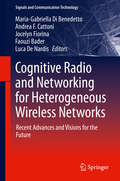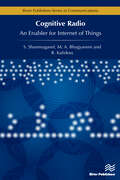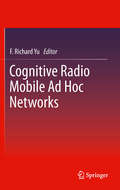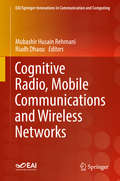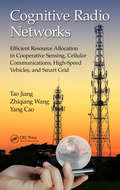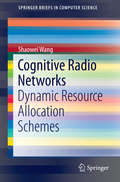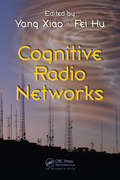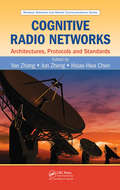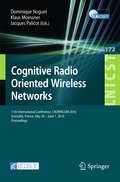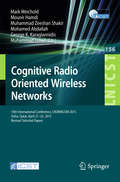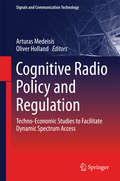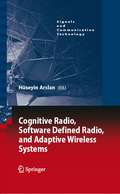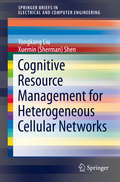- Table View
- List View
Cognitive Radio and Networking for Heterogeneous Wireless Networks: Recent Advances and Visions for the Future (Signals and Communication Technology)
by Maria-Gabriella Di Benedetto Andrea F. Cattoni Jocelyn Fiorina Faouzi Bader Luca De NardisThis book, written by leading experts from academia and industry, offers a condensed overview on hot topics among the Cognitive Radios and Networks scientific and industrial communities (including those considered within the framework of the European COST Action IC0902) and presents exciting visions for the future. Examples of the subjects considered include the design of new filter bank-based air interfaces for spectrum sharing, medium access control design protocols, the design of cloud-based radio access networks, an evolutionary vision for the development and deployment of cognitive TCP/IP, and regulations relevant to the development of a spectrum sharing market. The concluding chapter comprises a practical, hands-on tutorial for those interested in developing their own research test beds. By focusing on the most recent advances and future avenues, this book will assist researchers in understanding the current issues and solutions in Cognitive Radios and Networks designs.
Cognitive Radio Architecture: The Engineering Foundations of Radio XML
by Joseph Mitola IIIAn exciting new technology, described by the one who invented it This is the first book dedicated to cognitive radio, a promising new technology that is poised to revolutionize the telecommunications industry with increased wireless flexibility. Cognitive radio technology integrates computational intelligence into software-defined radio for embedded intelligent agents that adapt to RF environments and user needs. Using this technology, users can more fully exploit the radio spectrum and services available from wireless connectivity. For example, an attempt to send a 10MB e-mail in a zone where carrier charges are high might cause a cognitive radio to alert its user and suggest waiting until getting to the office to use the LAN instead. Cognitive Radio Architecture examines an "ideal cognitive radio" that features autonomous machine learning, computer vision, and spoken or written language perception. The author of this exciting new book is the inventor of the technology and a leader in the field. Following his step-by-step introduction, readers can start building aware/adaptive radios and then make steps towards cognitive radio. After an introduction to adaptive, aware, and cognitive radio, the author develops three major themes in three sections: Foundations Radio Competence User Domain Competence The book makes the design principles of cognitive radio more accessible to students of teleinformatics, as well as to wireless communications systems developers. It therefore embraces the practice of cognitive radio as well as the theory. In particular, the publication develops a cognitive architecture that integrates disparate disciplines, including autonomous machine learning, computer vision, and language perception technologies. An accompanying CD-ROM contains the Java source code and compiled class files for applications developed in the book. In addition, for the convenience of the reader, Web resources introducing key concepts such as speech applications programmer interfaces (APIs) are included. Although still five to ten years away from full deployment, telecommunications giants and research labs around the world are already dedicating R&D to this new technology. Telecommunications engineers as well as advanced undergraduate and graduate students can learn the promising possibilities of this innovative technology from the one who invented it. Note: CD-ROM/DVD and other supplementary materials are not included as part of eBook file.
Cognitive Radio - An Enabler for Internet of Things
by R. Kalidoss M. A. Bhagyaveni K. S. VishvaksenanInternet of Things (IoT) deals with the interconnection of devices that can communicate with each other over the internet. Currently, several smart systems have evolved with the evolution in IoT. Cognitive Radio - an enabler for Internet of Things is a research level subject for all communication engineering students at undergraduate, post graduate and research levels. The contents of the book are designed to cover the prescribed syllabus for one semester course on the subject prescribed by universities. Concepts have been explained thoroughly in simple and lucid language. Mathematical analysis has been used wherever necessary followed by clear and lucid explanation of the findings and their implication. Key technologies presented include dynamic spectrum access, spectrum sensing techniques, IEEE 802.22 and different radio network architectures. Their role and use in the context of mobile broadband access in general is explained, giving both a high level overview and a detailed step by step explanation. The book includes a large number of diagrams, MATLAB examples, thereby enabling the readers to have a sound grasp of the concepts presented and their applications. This book is a must have resource for engineers and other professionals in the telecommunication industry working with cellular or wireless broadband technologies, helping comprehension of the process of utilization of the updated technology to enable being ahead competition.
Cognitive Radio - An Enabler for Internet of Things
by R. Kalidoss M. A. Bhagyaveni K. S. VishvaksenanInternet of Things (IoT) deals with the interconnection of devices that can communicate with each other over the internet. Currently, several smart systems have evolved with the evolution in IoT. Cognitive Radio - an enabler for Internet of Things is a research level subject for all communication engineering students at undergraduate, post graduate and research levels. The contents of the book are designed to cover the prescribed syllabus for one semester course on the subject prescribed by universities. Concepts have been explained thoroughly in simple and lucid language. Mathematical analysis has been used wherever necessary followed by clear and lucid explanation of the findings and their implication. Key technologies presented include dynamic spectrum access, spectrum sensing techniques, IEEE 802.22 and different radio network architectures. Their role and use in the context of mobile broadband access in general is explained, giving both a high level overview and a detailed step by step explanation. The book includes a large number of diagrams, MATLAB examples, thereby enabling the readers to have a sound grasp of the concepts presented and their applications. This book is a must have resource for engineers and other professionals in the telecommunication industry working with cellular or wireless broadband technologies, helping comprehension of the process of utilization of the updated technology to enable being ahead competition.
Cognitive Radio Mobile Ad Hoc Networks
by F. Richard YuCognitive radios (CR) technology is capable of sensing its surrounding environment and adapting its internal states by making corresponding changes in certain operating parameters. CR is envisaged to solve the problems of the limited available spectrum and the inefficiency in the spectrum usage. CR has been considered in mobile ad hoc networks (MANETs), which enable wireless devices to dynamically establish networks without necessarily using a fixed infrastructure. The changing spectrum environment and the importance of protecting the transmission of the licensed users of the spectrum mainly differentiate classical MANETs from CR-MANETs. The cognitive capability and re-configurability of CR-MANETs have opened up several areas of research which have been explored extensively and continue to attract research and development. The book will describe CR-MANETs concepts, intrinsic properties and research challenges of CR-MANETs. Distributed spectrum management functionalities, such as spectrum sensing and sharing, will be presented. The design, optimization and performance evaluation of security issues and upper layers in CR-MANETs, such as transport and application layers, will be investigated.
Cognitive Radio, Mobile Communications and Wireless Networks (EAI/Springer Innovations in Communication and Computing)
by Mubashir Husain Rehmani Riadh DhaouThis book provides an overview of the latest research and development of new technologies for cognitive radio, mobile communications, and wireless networks. The contributors discuss the research and requirement analysis and initial standardization work towards 5G cellular systems and the capacity problems it presents. They show how cognitive radio, with the capability to flexibly adapt its parameters, has been proposed as the enabling technology for unlicensed secondary users to dynamically access the licensed spectrum owned by legacy primary users on a negotiated or an opportunistic basis. They go on to show how cognitive radio is now perceived in a much broader paradigm that will contribute to solve the resource allocation problem that 5G requirements raise. The chapters represent hand-selected expanded papers from EAI sponsored and hosted conferences such as the 12th EAI International Conference on Mobile and Ubiquitous Systems, the 11th EAI International Conference on Heterogeneous Networking for Quality, Reliability, Security and Robustness, the 10th International Conference on Cognitive Radio Oriented Wireless Networks, the 8th International Conference on Mobile Multimedia Communications, and the EAI International Conference on Software Defined Wireless Networks and Cognitive Technologies for IoT.
Cognitive Radio Networks: Medium Access Control for Coexistence of Wireless Systems
by Kaigui Bian Jung-Min Park Bo GaoThis book gives a comprehensive overview of the medium access control (MAC) principles in cognitive radio networks, with a specific focus on how such MAC principles enable different wireless systems to coexist in the same spectrum band and carry out spectrum sharing. From algorithm design to the latest developments in the standards and spectrum policy, readers will benefit from leading-edge knowledge of how cognitive radio systems coexist and share spectrum resources. Coverage includes cognitive radio rendezvous, spectrum sharing, channel allocation, coexistence in TV white space, and coexistence of heterogeneous wireless systems.
Cognitive Radio Networks
by Kwang-Cheng Chen Ramjee PrasadGiving a basic overview of the technologies supporting cognitive radio this introductory-level text follows a logical approach, starting with the physical layer and concluding with applications and general issues. It provides a background to advances in the field of cognitive radios and a new exploration of how these radios can work together as a network. Cognitive Radio Networks starts with an introduction to the fundamentals of wireless communications, introducing technologies such as OFDM & MIMO. It moves onto cover software defined radio and explores and contrasts wireless, cooperative and cognitive networks and communications. Spectrum sensing, medium access control and network layer design are examined before the book concludes by covering the topics of trusted cognitive radio networks and spectrum management. Unique in providing a brief but clear tutorial and reference to cognitive radio networks this book is a single reference, written at the appropriate level for newcomers as well as providing an encompassing text for those with more knowledge of the subject. One of the first books to provide a systematic description of cognitive radio networks Provides pervasive background knowledge including both wireless communications and wireless networks Written by leading experts in the field Full network stack investigation
Cognitive Radio Networks: Efficient Resource Allocation in Cooperative Sensing, Cellular Communications, High-Speed Vehicles, and Smart Grid
by Tao Jiang Yang Cao Zhiqiang WangResource allocation is an important issue in wireless communication networks. In recent decades, cognitive radio-based networks have garnered increased attention and have been well studied to overcome the problem of spectrum scarcity in future wireless communication systems. Many new challenges in resource allocation appear in cognitive radio-based networks. This book focuses on effective resource allocation solutions in several important cognitive radio-based networks, including opportunistic spectrum access networks, cooperative sensing networks, cellular networks, high-speed vehicle networks, and smart grids.
Cognitive Radio Networks: Efficient Resource Allocation in Cooperative Sensing, Cellular Communications, High-Speed Vehicles, and Smart Grid
by Tao Jiang Yang Cao Zhiqiang WangResource allocation is an important issue in wireless communication networks. In recent decades, cognitive radio-based networks have garnered increased attention and have been well studied to overcome the problem of spectrum scarcity in future wireless communication systems. Many new challenges in resource allocation appear in cognitive radio-based networks. This book focuses on effective resource allocation solutions in several important cognitive radio-based networks, including opportunistic spectrum access networks, cooperative sensing networks, cellular networks, high-speed vehicle networks, and smart grids.
Cognitive Radio Networks: Dynamic Resource Allocation Schemes (SpringerBriefs in Computer Science)
by Shaowei WangThis SpringerBrief presents a survey of dynamic resource allocation schemes in Cognitive Radio (CR) Systems, focusing on the spectral-efficiency and energy-efficiency in wireless networks. It also introduces a variety of dynamic resource allocation schemes for CR networks and provides a concise introduction of the landscape of CR technology. The author covers in detail the dynamic resource allocation problem for the motivations and challenges in CR systems. The Spectral- and Energy-Efficient resource allocation schemes are comprehensively investigated, including new insights into the trade-offs for operating strategies. Promising research directions on dynamic resource management for CR and the applications in other wireless communication systems are also discussed. Cognitive Radio Networks: Dynamic Resource Allocation Schemes targets computer scientists and engineers working in wireless communications. Advanced-level students in computer science and electrical engineering will also find this brief useful reading about the next generation of wireless communication.
Cognitive Radio Networks
by Yang Xiao Fei HuFueled by ongoing and increasing consumer demand, the explosive growth in spectrum-based communications continues to tax the finite resources of the available spectrum. One possible solution, Cognitive Radio Network (CRN), allows unlicensed users opportunistic access to licensed bands without interfering with existing users. Although some initial s
Cognitive Radio Networks: Architectures, Protocols, and Standards
by Yan Zhang Jun Zheng Hsiao-Hwa ChenWhile still in the early stages of research and development, cognitive radio is a highly promising communications paradigm with the ability to effectively address the spectrum insufficiency problem. Written by those pioneering the field, Cognitive Radio Networks: Architectures, Protocols, and Standards offers a complete view of cognitive radio-incl
Cognitive Radio Oriented Wireless Networks: 11th International Conference, CROWNCOM 2016, Grenoble, France, May 30 - June 1, 2016, Proceedings (Lecture Notes of the Institute for Computer Sciences, Social Informatics and Telecommunications Engineering #172)
by Dominique Noguet Klaus Moessner Jacques PalicotThis book constitutes the thoroughly refereed conference proceedings of the 11th International Conference on Cognitive Radio Oriented Wireless Networks, CROWNCOM 2016, held in Grenoble, France, May 30 – April 1, 2016.The 62 revised full papers presented were carefully reviewed and selected from numerous submissions and cover the evolution of cognitive radio technology pertaining to 5G networks. The papers are clustered to topics on dynamic spectrum access/management, networking protocols for CR, modeling and theory, HW architecture and implementations, next generation of cognitive networks, standards and business models, emerging applications for cognitive networks.
Cognitive Radio Oriented Wireless Networks: 10th International Conference, CROWNCOM 2015, Doha, Qatar, April 21-23, 2015, Revised Selected Papers (Lecture Notes of the Institute for Computer Sciences, Social Informatics and Telecommunications Engineering #156)
by Mark Weichold Mounir Hamdi Muhammad Zeeshan Shakir Mohamed Abdallah George K. Karagiannidis Muhammad IsmailThis book constitutes the thoroughly refereed post-conference proceedings of the 10th International Conference on Cognitive Radio Oriented Wireless Networks, CROWNCOM 2015, held in Doha, Qatar, in April 2015. The 66 revised full papers presented were carefully reviewed and selected from 110 submissions and cover the evolution of cognitive radio technology pertaining to 5G networks. The papers are clustered to topics on dynamic spectrum access/management, networking protocols for CR, modeling and theory, HW architecture and implementations, next generation of cognitive networks, standards and business models, and emerging applications for cognitive networks.
Cognitive Radio Policy and Regulation: Techno-Economic Studies to Facilitate Dynamic Spectrum Access (Signals and Communication Technology)
by Arturas Medeisis Oliver HollandThis book offers a timely reflection on how the proliferation of advanced wireless communications technologies, particularly cognitive radio (CR) can be enabled by thoroughly-considered policy and appropriate regulation. It looks at the prospects of CR from the divergent standpoints of technological development and economic market reality. The book provides a broad survey of various techno-economic and policy aspects of CR development and provides the reader with an understanding of the complexities involved as well as a toolbox of possible solutions to enable the evolutionary leap towards successful implementation of disruptive CR technology or indeed any other novel wireless technologies. Cognitive Radio Policy and Regulation showcases the original ideas and concepts introduced into the field of CR and dynamic spectrum access policy over nearly four years of work within COST Action IC0905 TERRA, a think-tank with participants from more than 20 countries. The book’s subject matter includes:• deployment scenarios for CR;• technical approaches for improved spectrum sharing;• economic aspects of CR policy and regulation;• impact assessment of cognitive and software-defined radio; and• novel approaches to spectrum policy and regulation for the age of CR.The book will interest researchers in the field of wireless communications, especially those working with standardization and policy issues, as well as industry and regulatory professionals concerned with radio spectrum management and the general development of wireless communications. Considerable complementary reference material such as power point slides and technical reports that illustrates and expands on the contents of the book is provided on the companion website to the book, found at http://www.cost-terra.org/CR-policy-book
Cognitive Radio Receiver Front-Ends: RF/Analog Circuit Techniques (Analog Circuits and Signal Processing #115)
by Bodhisatwa Sadhu Ramesh HarjaniThis book focuses on the architecture and circuit design for cognitive radio receiver front-ends. The authors first provide a holistic explanation of RF circuits for cognitive radio systems. This is followed by an in-depth exploration of existing techniques that can be utilized by circuit designers. Coverage also includes novel circuit techniques and architectures that can be invaluable for designers for cognitive radio systems.
Cognitive Radio, Software Defined Radio, and Adaptive Wireless Systems (Signals and Communication Technology)
by Hüseyin ArslanToday’s wireless services have come a long way since the roll out of the conventional voice-centric cellular systems. The demand for wireless access in voice and high rate data multi-media applications has been increasing. New generation wireless communication systems are aimed at accommodating this demand through better resource management and improved transmission technologies. This book discusses the cognitive radio, software defined radio, and adaptive radio concepts from several perspectives.
Cognitive Resource Management for Heterogeneous Cellular Networks (SpringerBriefs in Electrical and Computer Engineering)
by Yongkang Liu Xuemin (Sherman) ShenThis Springer Brief focuses on cognitive resource management in heterogeneous cellular networks (Het Net) with small cell deployment for the LTE-Advanced system. It introduces the Het Net features, presents practical approaches using cognitive radio technology in accommodating small cell data relay and optimizing resource allocation and examines the effectiveness of resource management among small cells given limited coordination bandwidth and wireless channel uncertainty. The authors introduce different network characteristics of small cell, investigate the mesh of small cell access points in parallel with macrocells in network control and resource management and address resource management in the backhaul with coordination constraints and wireless channel uncertainty. The final section of this brief summarizes and provides future research directions for this topic, including a proposed framework that has been evaluated through realistic simulations. Cognitive Resource Management for Heterogeneous Cellular Networks is designed for researchers and professionals working in wireless communications and networks. Advanced-level students studying electrical and computer engineering should also find the content helpful.
Cognitive Technologies (Telecommunications and Information Technology)
by Alberto Paradisi Fabrício Lira Figueiredo Rafael Carvalho Figueiredo Alan Godoy Souza MelloThis book focuses on the next generation optical networks as well as mobile communication technologies. The reader will find chapters on Cognitive Optical Network, 5G Cognitive Wireless, LTE, Data Analysis and Natural Language Processing. It also presents a comprehensive view of the enhancements and requirements foreseen for Machine Type Communication. Moreover, some data analysis techniques and Brazilian Portuguese natural language processing technologies are also described here.
Cognitive Underwater Acoustic Networking Techniques (SpringerBriefs in Electrical and Computer Engineering)
by Dimitri Sotnik Michael Goetz Ivor NissenThis book summarizes the latest research on cognitive network-layer methods and smart adaptive physical-layer methods in underwater networks. Underwater communication requires extendable and delay-tolerant underwater acoustic networks capable of supporting multiple frequency bands, data rates and transmission ranges. The book also discusses a suitable foreground communication stack for mixed mobile/static networks, a technology that requires adaptive physical layer waveforms and cognitive network strategies with underlying cooperative and non-cooperative robust processes. The goal is to arrive at a universally applicable standard in the area of Underwater Internet-of-Things [ISO/IEC 30140, 30142, 30143]. The book is the second spin-off of the research project RACUN, after the first RACUN-book "Underwater Acoustic Networking Techniques" (https://link.springer.com/book/10.1007%2F978-3-642-25224-2)
Cognitive Vehicular Networks
by Anna Maria Vegni Dharma P. AgrawalA comprehensive text on both current and emerging areas of cognitive vehicular networks, this book focuses on a new class of mobile ad hoc networks. It uses a pedagogical approach utilizing cognitive aspects applied to vehicular environments and comprises contributions from well-known and high profile researchers in their respective specialties. The book provides significant technical and practical insights on different perspectives, starting from a basic background on cognitive radio, interrelated technologies, application to vehicular networks, technical challenges, and future trends.
Cognitive Vehicular Networks
by Anna Maria Vegni Dharma P. AgrawalA comprehensive text on both current and emerging areas of cognitive vehicular networks, this book focuses on a new class of mobile ad hoc networks. It uses a pedagogical approach utilizing cognitive aspects applied to vehicular environments and comprises contributions from well-known and high profile researchers in their respective specialties. The book provides significant technical and practical insights on different perspectives, starting from a basic background on cognitive radio, interrelated technologies, application to vehicular networks, technical challenges, and future trends.
Cognitive Virtual Network Operator Games (SpringerBriefs in Computer Science)
by Lingjie Duan Jianwei Huang Biying ShouThis SpringerBrief provides an overview of cognitive mobile virtual network operator’s (C-MVNO) decisions under investment flexibility, supply uncertainty, and market competition in cognitive radio networks. This is a new research area at the nexus of cognitive radio engineering and microeconomics. The authors focus on an operator’s joint spectrum investment and service pricing decisions. The readers will learn how to tradeoff the two flexible investment choices (dynamic spectrum leasing and spectrum sensing) under supply uncertainty. Furthermore, if there is more than one operator, we present analysis of the competition among operators in obtaining spectrum and pricing services to attract users. The brief is designed for professionals working with C-MVNOs. Succinct and practical, it will assist them in making optimal investments and pricing decisions. It will also be of interest to researchers.
Cognitive Wireless Communication Networks
by Ekram Hossain Vijay K. BhargavaThis book provides a unified view on the state-of-the-art of cognitive radio technology. It includes a set of research and survey articles featuring the recent advances in theory and applications of cognitive radio technology for the next generation (e.g., fourth generation) wireless communication networks. The contributed articles cover both the theoretical concepts (e.g., information-theoretic analysis) and system-level implementation issues.
